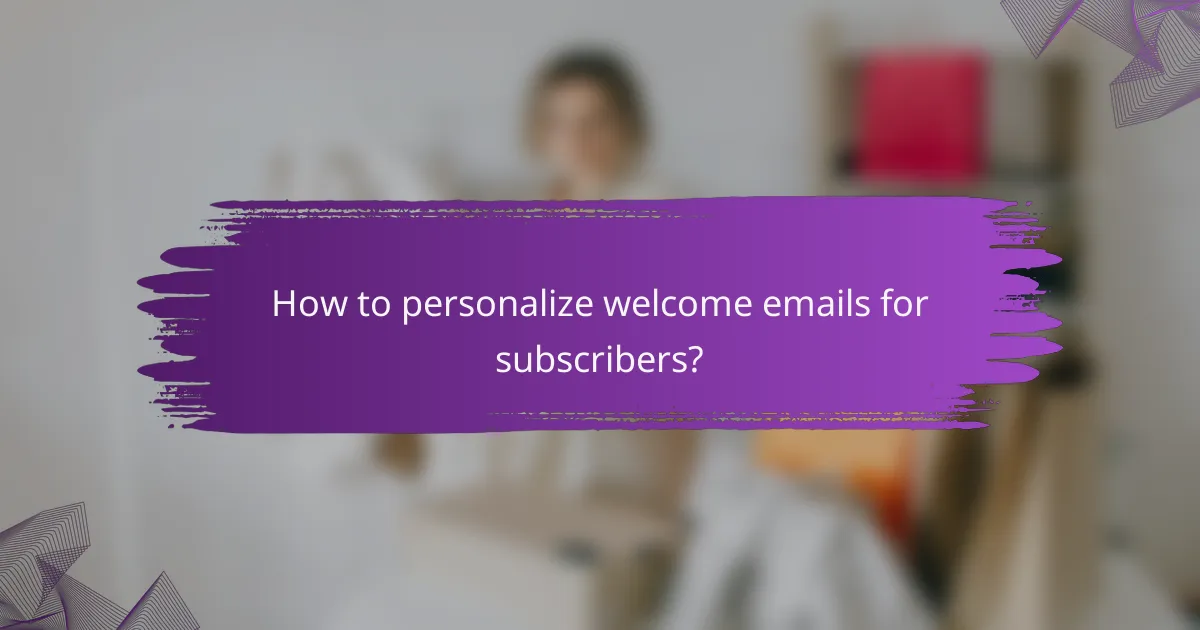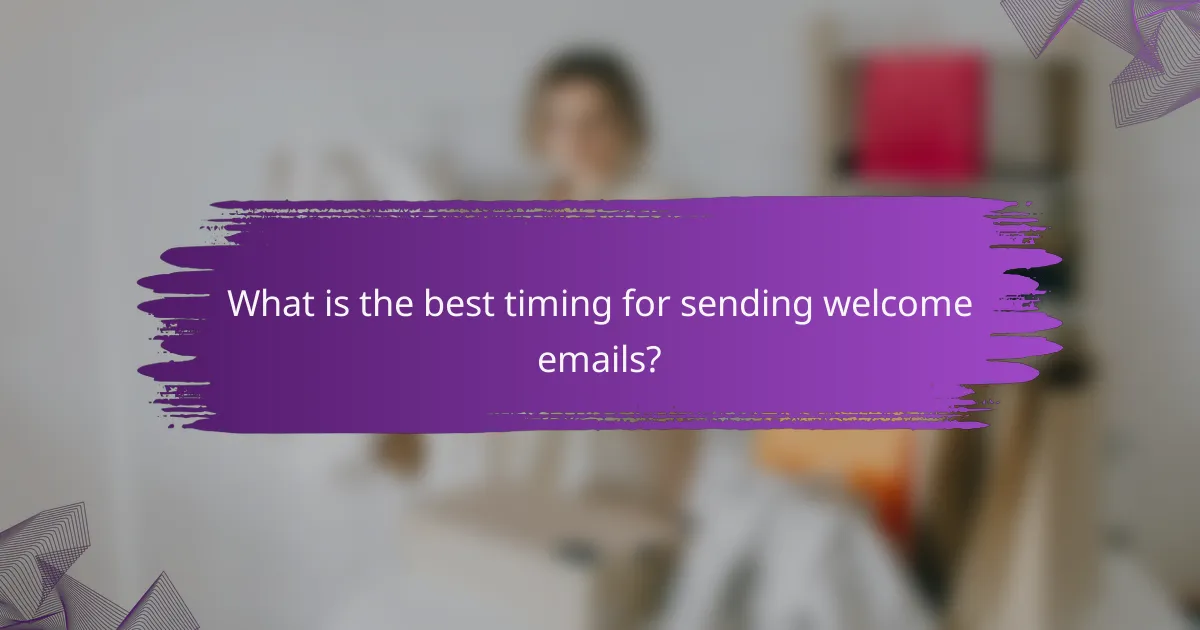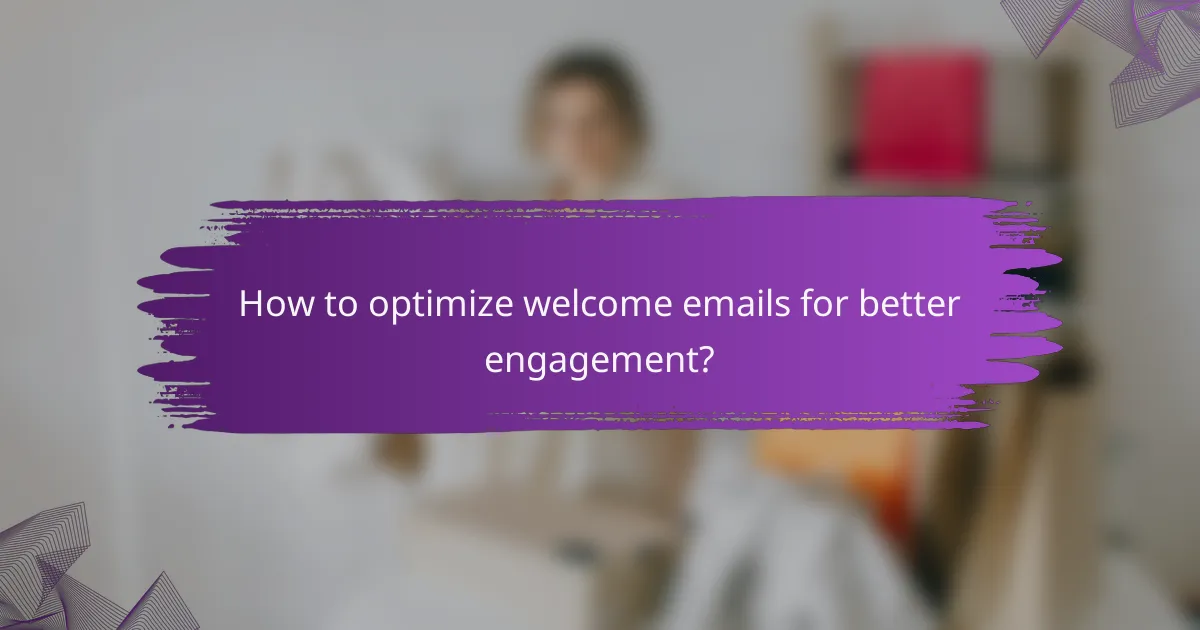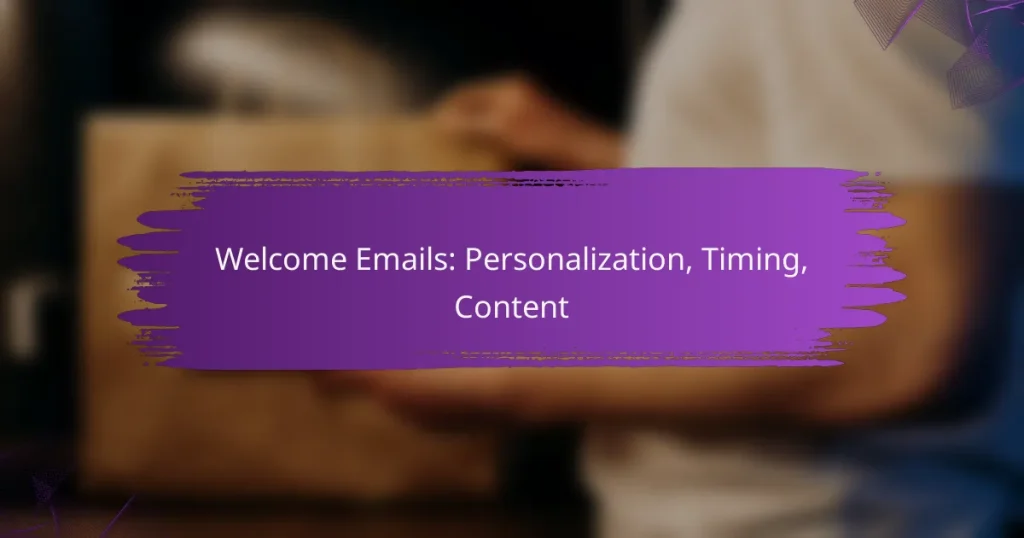Welcome emails are a crucial touchpoint for engaging new subscribers and building a lasting relationship. By personalizing these messages and sending them promptly after sign-up, you can effectively convey your brand’s value and encourage further interaction. Including essential elements such as a brand introduction, clear value propositions, and actionable calls to action can significantly enhance the effectiveness of your welcome emails.

How to personalize welcome emails for subscribers?
Personalizing welcome emails enhances subscriber engagement and fosters a connection with your audience. Key strategies include using the subscriber’s name, segmenting based on interests, and incorporating user behavior data.
Use subscriber’s name
Including the subscriber’s name in the welcome email creates an immediate personal touch. It can significantly increase open rates and engagement, making the email feel more tailored and relevant.
To implement this, ensure your email platform supports personalization tokens. For example, use “Hi [First Name]” instead of a generic greeting. This small change can make a big difference in how recipients perceive your message.
Segment based on interests
Segmenting your audience based on their interests allows for more targeted communication. By categorizing subscribers into groups, you can tailor content that resonates with each segment’s preferences.
Consider using sign-up forms that ask for preferences or interests. This data can guide your email content, ensuring that subscribers receive information that is relevant to them, which can improve engagement rates.
Incorporate user behavior data
User behavior data, such as past purchases or website interactions, can inform your welcome emails. By analyzing this data, you can create messages that reflect the subscriber’s journey with your brand.
For instance, if a subscriber recently browsed a specific product category, mention those products in the welcome email. This approach not only personalizes the experience but also encourages further exploration and potential purchases.
Utilize dynamic content
Dynamic content allows you to customize email elements based on subscriber data in real-time. This means different subscribers can see different images, offers, or messages within the same email template.
For example, if you have subscribers from various regions, you can display location-specific promotions or events. This level of personalization can significantly enhance the relevance of your emails.
Include personalized recommendations
Personalized recommendations based on subscriber behavior or preferences can drive engagement and sales. By suggesting products or content that align with their interests, you create a more compelling reason for them to interact with your brand.
Utilize algorithms or recommendation engines that analyze user data to suggest items. For example, if a subscriber showed interest in outdoor gear, recommend related products like hiking boots or camping equipment in the welcome email.

What is the best timing for sending welcome emails?
The best timing for sending welcome emails is immediately after a user signs up. This prompt delivery helps establish a connection and reinforces the user’s decision to engage with your brand.
Send immediately after sign-up
Sending a welcome email right after sign-up is crucial for capturing the user’s attention while their interest is high. This email should confirm their registration and provide essential information about what to expect next. A quick response can lead to higher engagement rates and a positive first impression.
For optimal results, ensure that your email is triggered automatically by the sign-up action. This approach minimizes delays and ensures that the user receives your message at the peak of their engagement.
Test different time zones
When sending welcome emails, consider the time zones of your users. If your audience is global, testing different sending times can reveal when your emails are most likely to be opened. This strategy can significantly enhance engagement rates, as users are more likely to read emails that arrive during their active hours.
Utilize A/B testing to compare performance across various time zones. This data-driven approach will help you identify the best times for your specific audience, leading to improved open and click-through rates.
Consider user engagement patterns
Understanding user engagement patterns is essential for timing your welcome emails effectively. Analyze when your users are most active on your platform or website to align your email delivery with their behavior. For instance, if users typically engage in the evenings, schedule your welcome emails accordingly.
Additionally, monitor the performance of your emails over time. Adjust your strategy based on engagement metrics, such as open rates and click-through rates, to continuously refine your timing for maximum impact.

What content should be included in welcome emails?
Welcome emails should include essential elements that introduce your brand, convey value, and encourage engagement. Key components include a brand introduction, a clear value proposition, actionable call-to-action links, onboarding tips, and exclusive offers to entice new subscribers.
Brand introduction
The brand introduction sets the tone for your relationship with new subscribers. It should provide a brief overview of your company, including its mission and core values. This helps recipients understand who you are and what they can expect from your communications.
Consider including a friendly greeting and a personal touch, such as the founder’s story or a fun fact about your brand. This creates a connection and makes your brand more relatable.
Value proposition
Your value proposition clearly communicates what makes your products or services unique. It should highlight the benefits that subscribers will gain by engaging with your brand, such as quality, convenience, or cost savings.
Use concise language to outline key features and advantages. For example, if you offer eco-friendly products, emphasize sustainability and how it benefits both the consumer and the environment.
Call-to-action links
Effective welcome emails should include clear call-to-action (CTA) links that guide recipients toward desired actions. These could be links to your website, product pages, or social media channels. Ensure that CTAs are visually distinct and easy to find.
Consider using action-oriented phrases like “Shop Now,” “Explore Our Collection,” or “Get Started” to encourage immediate engagement. Positioning CTAs strategically within the email can significantly increase click-through rates.
Onboarding tips
Onboarding tips help new subscribers navigate your offerings and maximize their experience. Provide practical advice on how to use your products or services effectively, or how to access exclusive content.
Consider creating a simple checklist or step-by-step guide to assist new users. This could include setting up an account, exploring features, or accessing customer support resources, ensuring they feel supported from the start.
Exclusive offers
Including exclusive offers in your welcome email can incentivize new subscribers to make their first purchase. This could be a discount, free shipping, or a special gift with their first order. Highlighting these offers creates a sense of urgency and excitement.
Make sure to clearly state any terms and conditions associated with the offer, such as expiration dates or minimum purchase requirements. This transparency builds trust and encourages action.

What are the key metrics for measuring welcome email success?
Key metrics for measuring welcome email success include open rates, click-through rates, and conversion rates. These metrics help assess how effectively your welcome emails engage recipients and drive desired actions.
Open rates
Open rates indicate the percentage of recipients who open your welcome email. A strong open rate typically falls between 15% and 30%, but this can vary based on industry and audience. To improve open rates, consider using personalized subject lines and sending emails at optimal times for your audience.
Monitoring open rates can help identify trends over time. If you notice a decline, it may be time to refresh your email content or re-evaluate your targeting strategies.
Click-through rates
Click-through rates (CTR) measure the percentage of recipients who click on links within your welcome email. A good CTR generally ranges from 2% to 5%, depending on your industry. To enhance CTR, include clear calls-to-action and engaging content that encourages interaction.
Testing different layouts and link placements can reveal what resonates best with your audience. Regularly analyze your CTR to refine your approach and boost engagement.
Conversion rates
Conversion rates reflect the percentage of recipients who complete a desired action after interacting with your welcome email, such as making a purchase or signing up for a service. A typical conversion rate for welcome emails can vary widely, often between 1% and 5%. Focus on aligning your email content with the specific actions you want recipients to take.
To improve conversion rates, ensure that your welcome email provides value and a seamless user experience. Consider offering incentives, such as discounts or exclusive content, to encourage recipients to convert.

How to optimize welcome emails for better engagement?
To enhance engagement with welcome emails, focus on personalization, timing, and relevant content. Tailoring messages to individual preferences and sending them at strategic moments can significantly boost open and click-through rates.
A/B testing subject lines
A/B testing subject lines involves sending two variations of an email to different segments of your audience to determine which subject line performs better. This method allows you to analyze metrics such as open rates and engagement levels to identify the most effective wording.
When conducting A/B tests, consider testing different elements such as length, tone, and urgency. For example, a subject line that includes a personalized touch, like the recipient’s name, may yield higher engagement compared to a generic one.
To optimize your A/B testing process, aim for a sample size that reflects your overall audience and run tests over a period that captures typical engagement patterns. Avoid testing too many variables at once to ensure clear results. A common practice is to test subject lines with a small percentage of your list before sending the winning version to the remainder.


